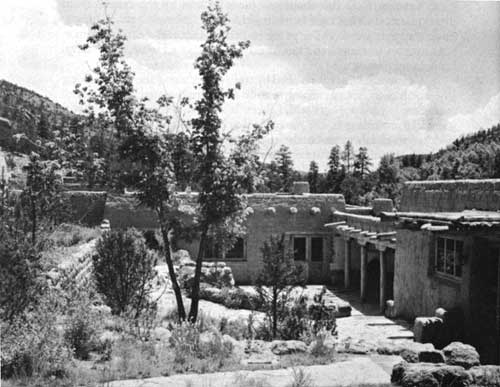|
BANDELIER National Monument |
 |

Frijoles Canyon Lodge, one of several verdant
patios.
About Your Visit
The monument is open every day of the year. The administration building and museum are open daily from 8 a. m. to 5 p. m. (from 8 a. m. to 9 p. m. in summer). Monument literature is available at the reception desk.
Interpretive services include self-guided tours to the principal ruins of Frijoles Canyon. Make application at the reception desk for the booklet and map which describe the walk.
Two other interpretive trails are provided, one visiting the ruins of Rainbow House immediately down canyon from headquarters; the other, in the Otowi Section, climbing to the mesa on which Tsankawi is situated. At the latter place, a booklet will guide you along the trail and tell you the archeological story, point by point.
Each evening from mid-June until Labor Day a program is presented at the administration building by a ranger or archeologist of the monument staff. The subjects of these informal talks range through many fields, from wildlife or botany to Indian ceremonials. Slides or movies are usually shown.
A campground is maintained near headquarters along the Rito de los Frijoles. Campsites are available in the shade of the grove which lines the stream; and fireplaces, tables, and firewood are provided. Housetrailers can be accommodated, and free toilet, shower, and laundry facilities are nearby.
Frijoles Canyon Lodge and Restaurant, directly opposite the administration building, provide excellent accommodations and meals under a concession contract from the National Park Service. The lodge is built of native stone in pueblo architecture, surrounding several landscaped patios; it is one of the more picturesque resorts of the Santa Fe region. The season for these accommodations is May 1 to October 15; no meals or rooms are available in the monument during the balance of the year. For reservations and further information write Frijoles Canyon Lodge, Bandelier National Monument, Santa Fe, N. Mex.
Horseback riding is very popular over the 50-mile network of trails. A saddle-horse concession is operated from April into October. Although the majority of riders take horses for the day only, overnight trips into the back country can be arranged.
Establishment and Administration
Adolph Bandelier, a Swiss-American historian and ethnologist, gave the first prominence to the Pajarito Plateau ruins as a result of his explorations and descriptions during the 1880's. Around the turn of the century a bill was introduced in Congress to create here a Cliff Cities National Park, it being apparent that some protection of the area was necessary to reduce the vandalism of the ruins. The bill, however, failed to pass. Presently, attention was again drawn to the area by the archeological work in Frijoles Canyon from 1909 to 1912, directed by the late Dr. Edgar L. Hewett. The renewed interest resulted in a proposal by the Secretary of Agriculture, in 1915, that a national monument be created. The Smithsonian Institution strongly supported this idea and recommended the name Bandelier in honor of the pioneer student of the region. The Secretary of Interior concurred, and as a result, on February 11, 1916, Bandelier National Monument was established by Presidential proclamation.
From 1916 until 1932, the monument was administered by the Forest Service of the United States Department of Agriculture. In 1952, the area was transferred to the National Park Service of the United States Department of the Interior, with a small adjustment of boundaries. The total area is now slightly over 27,000 acres. Since 1932, a National Park Service superintendent has been resident at monument headquarters in Frijoles Canyon. The monument has a small complement of rangers and fire guards for protection of the ruins, the wildlife, and the forests; in the summer, several temporary rangers are employed to aid in archeological interpretation.
Requests for further information should be addressed to the Superintendent, Bandelier National Monument, Santa Fe, N. Mex.
A number of other southwestern areas in the National Park System have been established for the protection of prehistoric structures. These include Mesa Verde National Park, in southwestern Colorado, and the following national monuments: Aztec Ruins, Chaco Canyon, and Gila Cliff Dwellings, in New Mexico; Canyon de Chelly, Casa Grande, Montezuma Castle, Navajo, Tonto, Tuzigoot, Walnut Canyon, and Wupatki, in Arizona.

|

|
|
Last Modified: Sat, Jan 6 2001 10:00:00 am PDT |


